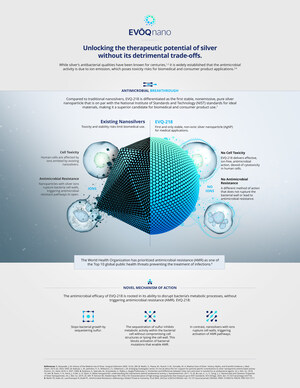Major Milestone for EVŌQ Nano's Biotech Arm Targeting Antibiotic-Resistant Bacterial Infections Linked to Cystic Fibrosis and Other Lung Diseases
SALT LAKE CITY, May 15, 2024 /PRNewswire/ -- EVŌQ Bio, a wholly-owned subsidiary of EVŌQ Nano, today announced the successful completion of a Pre-Investigational New Drug (pre-IND) meeting with the U.S. Food and Drug Administration (FDA) regarding the preclinical and clinical development plan for an inhaled therapeutic to treat pulmonary bacterial infections.
The inhaled therapeutic uses EVŌQ Nano's novel nanoparticle, EVQ-218, to combat pulmonary bacterial infections associated with cystic fibrosis and other lung diseases. The pre-IND meeting provided an opportunity to obtain the FDA's input on the IND development plan and guidance for preclinical and clinical studies. With positive feedback and regulatory clarity from the agency, EVŌQ Bio is confidently advancing toward Phase I clinical trials.
"The positive response from the FDA to our nanomedicine platform is a major milestone in the development of a new treatment for patients with cystic fibrosis and other bacterial lung infections," said EVŌQ Nano CEO Shaun Rothwell.
Cystic fibrosis is a genetic disorder causing thick, sticky mucus to build up in multiple organ systems including the lungs. This buildup clogs airways, leading to breathing difficulties and frequent lung infections. The disease can result in severe respiratory complications resulting from colonized, antibiotic-resistant bacterial infections in the lungs. EVŌQ Bio developed EVQ-218 to treat these infections.
EVŌQ Bio received two grants from the Cystic Fibrosis Foundation to help develop and test an inhaled therapeutic using EVQ-218 to eliminate bacterial growth in the lungs. In vitro studies found EVQ-218 demonstrated efficacy against pathogens linked to pulmonary infections. In vivo studies conducted to date demonstrate early safety and toxicity data, generating an initial safety profile of EVQ-218:
- Killed 64 strains from nine known drug-resistant bacteria, including Pseudomonas, Burkholderia, MSSA, MRSA, NTM, Achromobacter, Stenotrophomonas, Candida, and Scedosporium.
- Showed efficacy against 14 biofilms tested.
- Eradicated multiple yeast and filamentous fungi.
- Exhibited no toxicity in lung epithelial cells.
- No observable histopathologic findings.
- Developed no bacterial resistance during 28-day testing assay. Resistance to other antibiotics typically occurs in 4-5 days.1-5
Silver's Efficacy Transformed for Therapeutic Use
Characterized as a new form of silver,6 EVQ-218 is the first and only non-ionic silver nanoparticle with effective antimicrobial action devoid of cytotoxicity. EVQ-218 opens possibilities for widespread therapeutic use,7,8 as the ions in traditional nanosilvers have hindered its medical applications due to toxicity risks and limited stability.
The characterization of EVQ-218 is timely as the rise of antimicrobial resistance (AMR) has caused a surge of research into safer, more effective treatments. Prioritized by the World Health Organization as one of the top 10 global public health threats, AMR threatens the effective prevention and treatment of infections.9
About EVŌQ Bio
EVŌQ Bio is a preclinical-stage nanotherapeutics company pioneering a nanomedicine platform with demonstrated antimicrobial efficacy. The company's first therapeutic in development is for the treatment of pulmonary bacterial infections in patients with cystic fibrosis. The inhaled therapeutic utilizes EVQ-218, a groundbreaking nanoparticle that has demonstrated efficacy against a wide range of pathogens, including the top six antibiotic-resistant strains identified by the World Health Organization. Characterized as a new form of silver,6 EVQ-218 is the first and only non-ionic silver nanoparticle with effective antimicrobial action devoid of cytotoxicity. EVŌQ Bio is a wholly-owned subsidiary of EVŌQ Nano, which engineers novel nanoparticles for the life science, materials science, and textile science industries. To learn more, visit evoqbio.com.
Media Contact
Capwell Communications
[email protected]
References
1. Cakic M, Glisic S, Nikolic G. Synthesis, characterization and antimicrobial activity of dextran sulphate stabilized silver nanoparticles. J Mol Struct. 2016;1110:156–161. doi: 10.1016/j.molstruc.2016.01.040
2. Yan X, He B, Liu L, Qu G, Shi J, Hu L, Jiang G. Antibacterial mechanism of silver nanoparticles in Pseudomonas aeruginosa: Proteomics approach. Metallomics. 2018;10:557–564. doi: 10.1039/C7MT00328E
3. Gamboa SM, Rojas ER, Martínez VV, Vega-Baudrit J. Synthesis and characterization of silver nanoparticles and their application as an antibacterial agent. Int J Biosen Bioelectron. 2019;5(5):166-173. doi: 10.15406/ijbsbe.2019.05.00172
4. Rajeshkumar S, Bharath LV. Mechanism of plant-mediated synthesis of silver nanoparticles—A review on biomolecules involved, characterisation and antibacterial activity. Chem Biol Interact. 2017;273:219–227. doi: 10.1016/j.cbi.2017.06.019
5. Mikhailova EO. Silver nanoparticles: mechanism of action and probable bio-Application. J Funct Biomater. 2020 Dec; 11(4): 84. Published online 2020 Nov 26. doi: 10.3390/jfb11040084
6. Kennon BS, Niedermeyer WH. EVQ-218: Characterization of high-energy nanoparticles that measure up to NIST standards. ACS Omega. 2024;9(7):7891-7903. doi: 10.1021/acsomega.3c07745
7. Dimpka CO, Calder A, Gajjar P, Merugu S, Huang W, Britt DW, et al. Interaction of silver nanoparticles with an environmentally beneficial bacterium, Pseudomonas chlororaphis. J. Haz. Mat. 2011; 188:428-435. doi: 10.1016/j.jhazmat.2011.01.118
8. Niedermeyer W. Method and apparatus for production of uniformly sized nanoparticles. US 9 849 512, 2017.
9. World Health Organization. Prioritization of pathogens to guide discovery, research and development of new antibiotics for drug-resistant bacterial infections, including tuberculosis. 2017;77. (Survey of world health experts)
SOURCE EVOQ Nano

WANT YOUR COMPANY'S NEWS FEATURED ON PRNEWSWIRE.COM?
Newsrooms &
Influencers
Digital Media
Outlets
Journalists
Opted In






Share this article